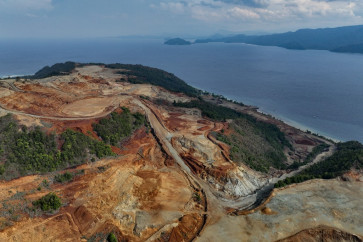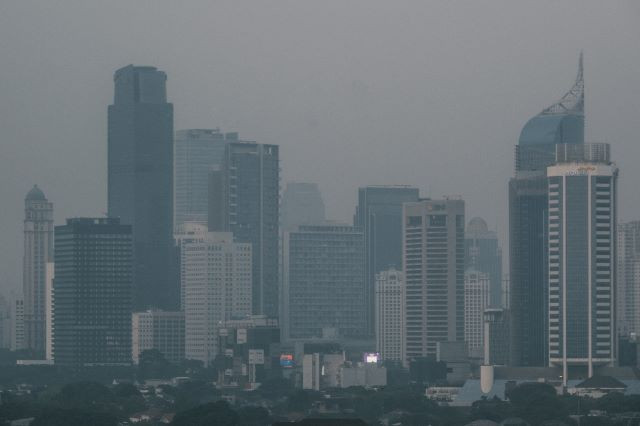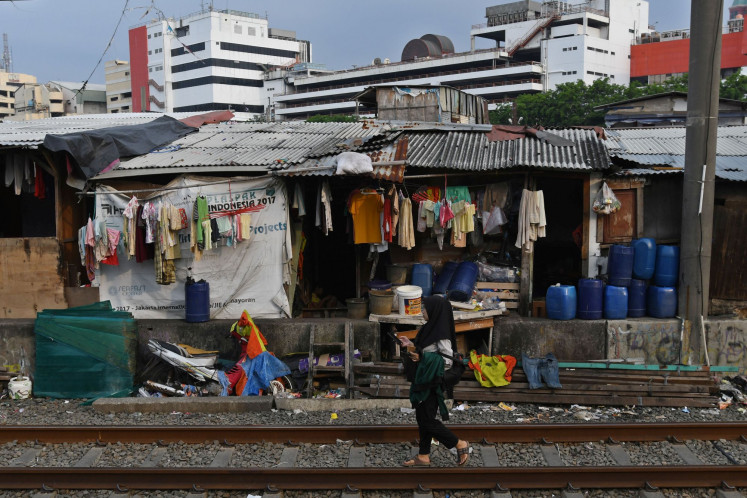Popular Reads
Top Results
Can't find what you're looking for?
View all search resultsPopular Reads
Top Results
Can't find what you're looking for?
View all search resultsThe Paradox of Sangiran
Clean room: Cow, goat and deer skeletons are stored in the conservation room of the Sangiran museum
Change text size
Gift Premium Articles
to Anyone

Clean room: Cow, goat and deer skeletons are stored in the conservation room of the Sangiran museum.
The area of Sangiran in Central Java would not have been known as a place where prehistoric humans lived without the discovery of fossils in 1934 by G. H. R. von Koenigswald, a German-Dutch paleontologist who contributed much to early hominid fossil research in Southeast Asia.
While the discovery of the rich fossil site has made the region a site of great historical and scientific importance, its fruit has yet to benefit the people who have long lived on that land.
'So far, around 80 individual prehistoric human fossils have been found ' over 50 percent of all such fossil finds in the world,' said Harry Widiyanto, the head of the Sangiran Early Man Site Preservation Center, about 15 kilometers north of Surakarta (Solo), Central Java.
'Some 13,000 fossils are stored in the Sangiran museum and their numbers are increasing,' Harry added.
According to the museum, Homo erectus, a human ancestor species, occupied the Sangiran region in the early to middle Pleistocene era, or around 1.8 million to hundreds of thousands of years ago. The human ancestors came to Java from Africa, leaving the continent 2.5 million years ago, settling in Sangiran after land bridges had receded.
According to the fossil record, tortoises, elephants, pigs and monkeys also lived near the site around 1.7 million years ago and served as the basic food of the human ancestors, supplementing healthy portions of marsh biota and local plants.
The three-story museum keeps over 3,000 fossils of human ancestors, land and sea animals and vegetation in addition to rocks and sediment dating as far back as 800,000 years ago.
The exhibits include fossilized bull horns, elephant leg bones and skulls, crocodile skulls and a diorama showing the life of Homo erectus in Sangiran 500,000 years back. There's also a model of the so-called Flores man based on the work of Elisabeth Daynes, Harry and Dominique Grimaud-Herve.
Many years ago ' relatively and not geologically speaking ' Sangiran was not a tourist attraction. Local residents living near the archeological site could also enjoy its rich grounds, as they were free to exploit and keep any fossils found. They quickly discovered that their finds could command astounding prices.
The region was a veritable gold mine for local residents, who sold fossils taken from barren farm land for tens of millions of rupiah.
Unsurprisingly, illegal trade in fossils flourished.
Eventually, residents were required to give their finds to the museum in exchange for nominal compensation, but the small size of the reimbursement and the long time needed to obtain it prompted them to sell objects on the black market.
'Locals were connected with would-be buyers by go-betweens. If they agreed with the price offered, payment was made right away,' said Wardoyo, a local resident of Sangiran.
However, after the enactment of Law No.5/1992 on cultural heritage objects, the fossil trade began to decline. Residents can now only engage in fossil excavation, mineral quarrying or sand digging in a limited way on their own land.
'We're forbidden to cultivate the land. In return, we get training in making stone handicrafts, early man statuettes, key ring ornaments, fossil replicas and T-shirts as souvenirs,' said Sulastri, a resident of Krikilan, Sangiran.
According to Harry, before the Sangiran site was made a technical executing unit under the Education and Culture Ministry, the independent museum had limited funds to pay residents in compensation for their finds. Even then, people had to wait up to three months for as little as Rp 200,000 (US$20.4), as the museum had to request funds from the head office in Jakarta. Since it has become a UPT, the museum has been able give out larger rewards faster.
'Recently we paid Rp 10 million in compensation for a fossilized bull skull. We've also paid Rp 2 million and Rp 4 million for different fossils. If the objects have been left in situ, the compensation can be greater. Certificates are given and the names of residents finding the fossils are recorded,' said Harry.
He said the ban against cultivation of land near the museum was meant to protect the historical legacy and scientific importance of Sangiran.
'This site is now considered to be in a damaged state, because about 80 percent of the zone has been exploited by locals. Such harm should be ended,' Harry said. The museum offered training to local residents so as to minimize the economic impact of the ban in exchange, he added.
'Marine animals like oysters and sea pebbles can be processed into handicrafts, as they're abundantly available ' but the discovery of artifacts and fossils must be reported,' Harry maintained.
For the last two years, 75 craftspeople have been part of the Sangiran Creative Economic Group, establishing a cooperative with 20 rent free kiosks. But there remains the problem of product quality, which hasn't met buyers' tastes.
'The museum shouldn't just provide training but also aid us with equipment. So far, we've only been offered opportunities. We strive for capital ourselves. With limited capital, we can't afford to buy modern devices,' said Kirman, a stone craftsman.
Krikilan village head Widodo said that residents around the museum hadn't yet fully benefitted from the presence of the Sangiran site. For example, the Rp 800 million collected in museum ticket sales, parking and toilet fees continue to be managed by the local tourism office.
'The village road leading to the museum is severely damaged. A good road would bring advantages to local residents as well as the museum,' remarked Widodo.
Meanwhile, the people who live nearby say that they can't benefit from their barren land, and can't even use clay to make bricks or roof tiles.
'The museum and regency administration hasn't yet seriously involved local residents in managing tourism in Sangiran,' Sulastri said.
'We're not satisfied.'
' Photos by Ganug Nugroho Adi









